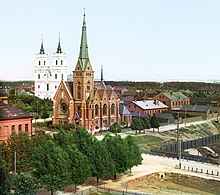Daugavpils
Daugavpils (Russian Даугавпилс; Latgalian Daugpiļs; Lithuanian Daugpilis) is the second largest city in Latvia.

Location
Daugavpils is located approximately 230 km south-east of the Latvian capital, Riga, on the banks of the Daugava River which is over 1000 km in length and which flows from its source in Russia, through Belarus and Latvia before entering the Baltic Sea via the Gulf of Riga.
The city has a favourable geographical position as it borders with Belarus and Lithuania (distances of 33 and 25 km respectively). It is located some 120 km from the borderline with Russia.
The city is surrounded by many lakes. All this makes the city a promising region for the development of international tourism.
Demographics
As of 1. January 2006 the city had a population of 108 260.
- Russians: 53,96% (958 414)
- Latvians: 17,3% (18 725)
- Poles: 14,9% (16 126)
- Belarusians: 8,22% (8 897)
- Ukrainians: 2,23% (2 417)
- Lithuanians: 0,96% (1 041)
- Jews: 0,45% (492)
- Estonians: 0,03% (30)
- Others: 1,96% (2 118).
History
The history of Daugavpils began in 1275 when a stone castle Dinaburg was built by the Livonian Order. Throughout Daugavpils history the city was part of different empires and city name was changed several times. It was Dinaburg (1275-1893) under Livonia. Later under Russian Empire it was Borisoglebsk (1656-1667) and Dvinsk (1893-1920). And finaly when Latvia declared its independance in 1918 it became Daugavpils (since 1920).
Daugavpils has several historical names in various languages (sometimes they are still used today):
- Borisoglebsk, Борисоглебск (Russian)1656–1667.
- Dźvinsk, Дзьвінск (Belarusian)
- Dvinsk, Двинcк (Russian)
- Dünaburg (German)
- Dźwinów, Dźwińsk, Dyneburg (Polish)
- Denenburg, דענענבורג (Yiddish)
Art, Architecture, and Culture
Daugavpils is an important cultural centre in Eastern Latvia. There are 22 primary and secondary schools, 4 vocational schools and the Saules College of Art. More than 1,000 teachers and engineers graduate from the Daugavpils Pedagogical University and local branch of the Riga Technical University annually.
The city theatre was restored a couple of years ago. Besides, there are also one cinema theater and other cultural institutions. The city exhibition centre offers a lot of cultural activities.
There are many architectural, historical and cultural monuments in Daugavpils. The most prominent is the Daugavpils Fortress of the eighteenth century.
Notable Residents
One of the most famous persons born in Daugavpils is abstract expressionist painter Mark Rothko.
In the early 20th century, Daugavpils simultaneously housed two prominent Rabbis: Meir Simcha of Dvinsk and Yosef Rozen (the Rogachover Gaon).
- Grzegorz Fitelberg
- Solomon Mikhoels
- Władysław Raginis
- Mark Rothko
- Yosef Rozen, the Rogachover Gaon
- Uljana Semjonova
- Meir Simcha of Dvinsk
See also
- Battle of Daugavpils
- Dinaburg FC (the Daugavpils football team)
